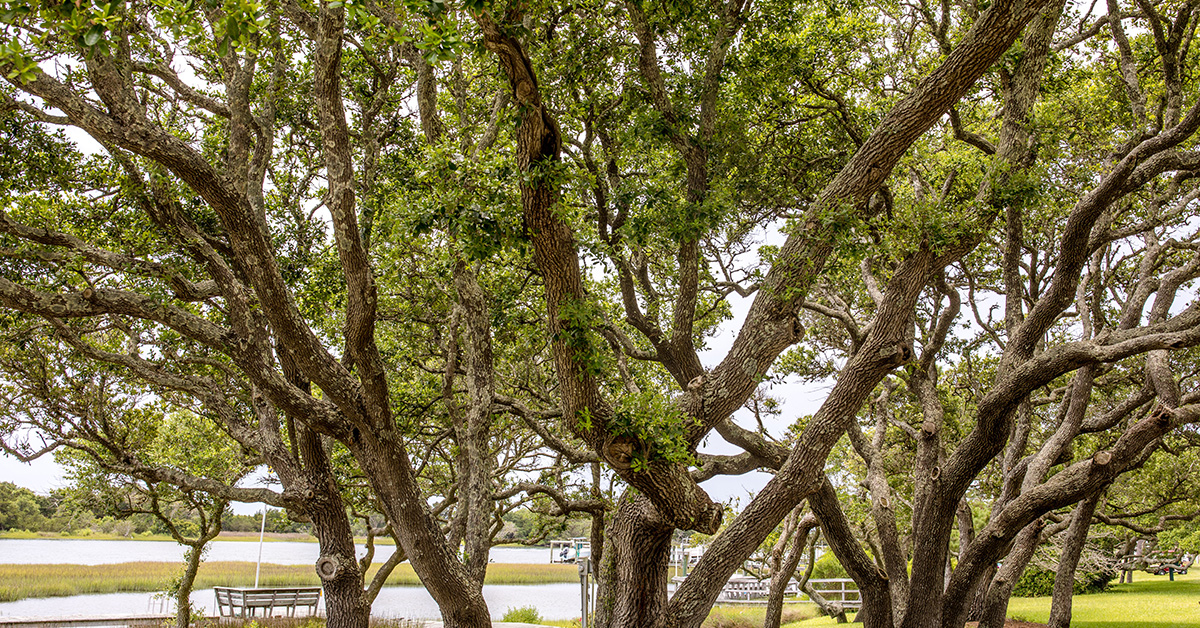Strolling through Beaufort’s Seafaring Past: Holiday Walk Features Historic Sites

It is the mid-1800s again in the historic Josiah Bell house in downtown Beaufort.
In a large yellow parlor with mauve woodwork, three women in Victorian-style dresses play the rich sound of “Oh Holy Night” on their harps.
In the adjoining parlor, three young girls, who look prim and proper in their long dresses, knit and embroider items near a tree trimmed with lace and German ornaments.
All of them are celebrating a Victorian-style Christmas, part of the Coastal Carolina Christmas walk held each year in Beaufort.
The walk showcases the Beaufort Historic site buildings, including a complex with a jail, courthouse and apothecary shop, as well as bed-and-breakfast establishments and other properties.
“Beaufort is the third oldest town in North Carolina,” says Patricia Suggs, director of the Beaufort Historical Association. “The walk is a fun and easy way for people to experience Beaufort and its historic sites.”
Tourists also can take a bus tour of the town during the holiday celebration.
Town’s Seafaring Past
Beaufort-by-the-sea, as the town is romantically called, has a captivating history that spans almost 300 years — from tales about the pirate Blackbeard to its use as a port in the 18th century for Spanish and French sailing ships.
During the 1600s, Beaufort was called “Fish Town” because American Indians used the waters for their fishing grounds.
Named in honor of Henry Somerset, Duke of Beaufort, the town was incorporated in 1723 and has been the seat of Carteret County ever since.
Street names reflect the early development of the town: Ann Street for Queen Anne; Craven Street for the Earl of Craven; Turner Street for Robert Turner, owner of the land that was surveyed for the town; Pollock Street for Gov. Thomas Pollock; and Orange Street for William, Prince of Orange, who became William III of England.
By the late 18th century, Beaufort was an active seaport inhabited by sailors, pirates, privateers, fishers, soldiers and planters. While the town’s busy sea trade connected Beaufort with seaports thousands of miles away, its geography kept it isolated from the interior of the state.
Railroad service began in 1907, and the first bridge for cars and trucks was built in 1926, according to Suggs.
This remoteness helped the town retain its traditional appearance. Today, the historic district has a large concentration of 18th- and 19th-century homes.
Porches are a dominant feature — from traditional cottages to elaborate Queen Anne and Greek revival residences. For example, the Langdon House, which was built in 1733 by a shipbuilder and is now used a as bed and breakfast, has front porches on the first and second level.
Many homes also have a second story “widow’s walk” used by sea captains’ wives to watch their husbands sail in and out of the port.
“There has been a surge in preservation and renovation efforts not only at the historic site but in the whole town,” says Suggs.
Bus Tour
The holiday tour begins with a ride around the historic district in a red 1948 English double-decker bus.
“It is really blowing today,” says the tour guide Carol Willis, dressed in a white cap, long maroon dress and gray cape. “Since there is no power steering on the bus, the driver has to use a lot of muscle.”
As the bus turns from Turner Street onto Front Street, she points out the N.C. Maritime Museum and the Watercraft Center across from it on Beaufort Sound.
Next to the museum is Cedars-by-the-Sea, now used as an inn. The home was built around 1768 by William Borden, the son of a Rhode Island shipwright and gracious host to visiting sea captains.
Although Borden was an important figure in the town, he never held public office because he was a Quaker and could not take an oath, Willis adds with a chuckle.
Next to the inn is the Easton home that was built in 1771 and still has its original ballast stone foundation.
“The eastern North Carolina-style home was used as a prison and hospital during the Civil War,” says Willis. “Researchers dug up a cannonball from the home.”
Sea Captain’s Home
One of the street’s famous residences is the Sloo house, where a ship captain lived with his young daughter who later died at sea after she contracted yellow fever. To preserve the girl’s body and bring it home, she was placed in a rum keg and later buried in the Old Burying Ground. To continue honoring the 13-year-old, people today put toys on her grave.
Near the end of Front Street is the Duncan home that was built in a Bahamian-style, with double porches, turned columns and three chimneys.
“It is on the lowest ground on Front Street,” says Willis. “For many years, the owners opened the front door when a storm came and let water run through the house,” she says.
As the bus turns onto the corner of Ann and Orange streets, the guide points out the Hatsell House with its two bright red doors.
Emeline Pigott, a Confederate spy and nurse for wounded troops during the Civil War, lived in the home, according to Willis. When collecting intelligence information for the
Confederates, Pigott stored the items in big pockets under her hoop skirts, Willis says.
“When she was arrested, the Union soldiers found 30 pounds of contraband under her skirts,” she adds.
‘They took her to New Bern to prison.”
The tour continues down Ann to Sunset Street and the John Hill house. Willis says that many homes on this and other streets were moved from other locations.
“People here moved houses like other people move furniture,” she adds. “Capt. John Hill first built the home on Portsmouth Island where it stood for 100 years. Then the home was loaded on a barge and moved to Beaufort for another 100 years before it was moved to its present location.”
As the bus heads back toward Ann Street, Willis points out a home surrounded by a quaint white picket fence that may have a connection to an early livestock law.
“Pigs found outside the fence could be slaughtered,” Willis says, adding that half of the money had to be given to the church to feed the hungry.
The bus slows down as it nears St. Paul’s Episcopal Church. “This is considered one of the 10 architecturally perfect buildings in the state,” says Willis. “It was constructed by shipbuilders, and the inside is like the hull of a ship.”
Haunted Cemetery
Not far from St. Paul’s is the Pirus Chapel, the oldest church in Beaufort. The AME Zion congregation now owns the chapel.
In front of the chapel is the Old Burying Ground — one of the oldest and most historic cemeteries in the state, now shaded with majestic oaks. Legends abound about those who are buried here.
“During the twilight hours, some say they have seen a cat jump out from a grave,” says Willis. “Some say it is Otway Burns, a hero who fought against the British during the War of 1812.”
After leaving the cemetery, the bus continues down Ann Street.
“When Beaufort was laid out, Queen Anne was on the throne,” she adds. “They planted apple trees on both sides of the street. After many hurricanes, only one or two apple trees are left.”
At the end of Ann Street, the bus turns onto a lane where the Hammock House stands on the highest point of land in Beaufort. Built in 1709 for a group of sea captains, it also is the town’s oldest home and one of the most intriguing because of its association with the famed pirate Blackbeard.
“Blackbeard lived here and brought one of his 14 brides,” says Willis. “The bride was a teenager. When Blackbeard left to go on a trip, she was isolated and lonely and had a party where she found a boyfriend.”
Later, Blackbeard came back and challenged the boyfriend to a duel, she adds. “That is why there are still blood stains on the stairs.”
One legend has it that the home’s residents often are awakened by the sound of women crying. “It is supposed to be a haunted house,” Willis adds.
One of the last stops on the trip is the Blare House, a gothic-style home on Marsh Street. “The home has an octagonal-shaped back room,” she says. It reportedly sold for a cow and half-a-calf in the 18th century.
Walking Tour
After the bus returns to Turner Street, the walking tour begins at the Beaufort Historic Site — which includes the Carteret County Courthouse of 1796, the oldest wood-framed courthouse in North Carolina.
The Church of England originally used the small-framed building as a meeting place, according to Daniel W. Barefoot’s Touring the Backroads of North Carolina’s Lower Coast. “During the War of 1812, the courthouse quartered American troops from Beaufort, Lenior and Craven counties,” the author says.
Today, the courthouse’s interior is painted Spanish brown to match the outside of the building. Trials were held at the courthouse until the mid-1800s, when it became a home, says the guide. In 1977, the building was moved from the square to its current site.
Next to the courthouse is a two-story jail that was constructed in 1836. The building has several cells and a jailkeeper’s quarters, as well as some unique artifacts. An upstairs holding room contains only one object: a rope last used for hanging a prisoner in 1875.
Another interesting stop is the apothecary. Authentic medical instruments, bottles and prescriptions are on display — from Lydia Pinkham’s vegetable tonic to an oil of youth “that won’t make you young but make you feel young.”
“The oil of youth was one of the favorites,” the tour guide says. “It sold for 50 cents a bottle. What a deal!”
In the back of the apothecary is a doctor’s office constructed in 1825 and filled with a variety of artifacts from 1936 or earlier — including an old stethoscope and a Red Cross flag from World War I.
“Dr. George Davis practiced here in the late 1800s to early 1900s,” the guide says.
Across Turner Street, the Mattie King Davis Art Gallery is decorated with colorful wreaths. The building, which was constructed in 1732, was originally called the Rustell home and moved to its present location in the early 1970s.
Nearby is the Leffers Cottage, a good example of “story and a jump” or a one-and-a-half story house.
Built by schoolmaster and clerk Samuel Leffers, the house is decorated with simple early American furnishings — from a spinning wheel to handmade rope bed. The living room mantel is adorned with a wreath made of turkey feathers.
Leffers migrated from Long Island to Beaufort to teach school in the 18th century. “In those days, school teachers were required to be sober and discreet, and be a quality man,” says the tour guide.
After the Revolutionary War, the militia was disbanded in Beaufort. However, British warships did not know the war was over and came into the harbor. The British used Leffers’ schoolhouse for a meeting place, but burned it before leaving town.
It’s a short walk down Turner Street to Ann Street, where the white-framed Ann Street Methodist Church is open for tours.
Inside, there is a large Christmas tree and a number of stained glass windows that reflect Beaufort’s maritime history, including anchors and nautical directional signs.
By the end of the tour, visitors realize that downtown Beaufort streets, waterfront and surroundings have changed little since the early days.
“No matter how many times you’ve been to Beaufort, there is always something different to see,” says Suggs.
The 2005 Carolina Walking Tour will be held from 2 to 4:30 p.m. Dec. 10 in Beaufort. For a complete list of tour stops, call 800/575-7483, 252/728-522; e-mail: beauforthistoricsite@earthlink.net or visit the Web: www.beauforthistoricsite.org.
This article was published in the Holiday 2005 issue of Coastwatch.
For contact information and reprint requests, visit ncseagrant.ncsu.edu/coastwatch/contact/.
- Categories:


